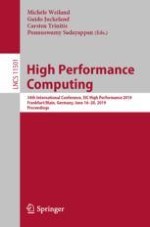This book constitutes the refereed proceedings of the 34th International Conference on High Performance Computing, ISC High Performance 2019, held in Frankfurt/Main, Germany, in June 2019.
The 17 revised full papers presented were carefully reviewed and selected from 70 submissions. The papers cover a broad range of topics such as next-generation high performance components; exascale systems; extreme-scale applications; HPC and advanced environmental engineering projects; parallel ray tracing - visualization at its best; blockchain technology and cryptocurrency; parallel processing in life science; quantum computers/computing; what's new with cloud computing for HPC; parallel programming models for extreme-scale computing; workflow management; machine learning and big data analytics; and deep learning and HPC.

 , are considered problematic as their weak type system and relaxed memory semantic allows for various, sometimes non-obvious, behaviors. Since compilers have to preserve the program semantics for all program executions, the existence of exceptional behavior can prevent optimizations that the developer would consider valid and might expect. Analyses to guarantee the absence of disruptive and unlikely situations are consequently an indispensable part of an optimizing compiler. However, such analyses have to be approximative and limited in scope as global and exact solutions are infeasible for any non-trivial program.
, are considered problematic as their weak type system and relaxed memory semantic allows for various, sometimes non-obvious, behaviors. Since compilers have to preserve the program semantics for all program executions, the existence of exceptional behavior can prevent optimizations that the developer would consider valid and might expect. Analyses to guarantee the absence of disruptive and unlikely situations are consequently an indispensable part of an optimizing compiler. However, such analyses have to be approximative and limited in scope as global and exact solutions are infeasible for any non-trivial program.